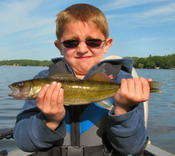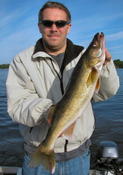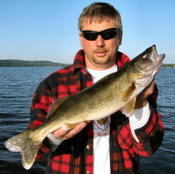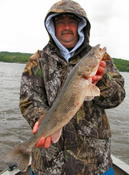 Several different clients in the last week chose to spend some quality time fishing with their sons while learning a new trick or two to put walleyes & saugers in the boat here on Lake Wisconsin. The fishing wasn’t great but it wasn’t bad either. We didn’t put any big walleyes in the boat but the numbers of fish caught are starting to improve.
Several different clients in the last week chose to spend some quality time fishing with their sons while learning a new trick or two to put walleyes & saugers in the boat here on Lake Wisconsin. The fishing wasn’t great but it wasn’t bad either. We didn’t put any big walleyes in the boat but the numbers of fish caught are starting to improve.
Six year old Logan Guenther holds up a walleye that he caught while trolling crank baits behind boards.
 Two different techniques were responsible for pretty much all of the walleyes, saugers & crappies boated this past week. The first involves trolling crank baits behind planer boards.
Two different techniques were responsible for pretty much all of the walleyes, saugers & crappies boated this past week. The first involves trolling crank baits behind planer boards.
How much line you run out behind the planer board and the lure you choose to use will determine how deep your crank bait will go. Here on Lake Wisconsin, there are two main considerations for choosing how deep to run your lures.
The first consideration is to get your baits in the strike zone and the 2nd consideration is spending more time fishing that you do pulling lures out of stumps.
Letting out to much line behind the planer board can end up being a test of your patience with trolling planer boards in the stump laden waters of Lake Wisconsin.
Don’t let out enough line and you won’t be in the strike zone and as a result, you will spend most of your time toodling around the lake watching lines that see little or no action at all.
On a typical day, depending on wind & cloud cover, I will start out with anywhere from 25-45′ of line behind the boards. As the sun gets higher in the sky, I may run as much as 60′ of line out behind the boards. The number of snags we get is directly related to the depth the lures run but so are the numbers of fish we catch. It’s a pretty fine balancing act and it does take some patience and time on the water to perfect. Catching some fish in-between the snags can lead to person having quite a bit more patience in this technique and learning how to be proficient with a lure retriever like the “Hound Dog Lure Retriever” can save you a pile of money from lost crank baits that run around $7.00 a pop!
Kurt Guenther holds up a nice 23″ walleye caught on a crank bait behind an Off Shore planer board.
 The second technique that is just starting to produce on a consistent basis for my boat is slow trolling crawler rigs behind bottom bouncers.
The second technique that is just starting to produce on a consistent basis for my boat is slow trolling crawler rigs behind bottom bouncers.
When I say crawler rigs, I’m talking about either slow death hooks or small spinners. (night crawler harnesses)
When running slow death hooks from Mustad, we always try to keep our boat speed between .7mph on the slow side to 1.1mph on the high side. With windy weather, that can be a bit of a trick and good quality drift socks like those made by Lindy Fishing Tackle, co. can be an absolute necessity.
Usually, we are running anywhere from four to six lines when bottom bouncing. On any given day, small spinner rigs may work better than the slow death hooks. That’s a good reason why you should mix a few of these rigs into the lineup from time to time.
Small spinners work well because they are light in weight and won’t sink down at the slow speeds needed to properly work slow death rigs. If your crawler harness rigs get to heavy, they will sink and snag up to often or they just won’t spin at all as they drag on the bottom.
Mike Gurklis holds up a fat walleye that fell for a crank bait behind a trolling board.
 We have also tried dragging jigs tipped with crawlers off and on but so far, that technique has not panned out for us.
We have also tried dragging jigs tipped with crawlers off and on but so far, that technique has not panned out for us.
What we really need to get these fish to put on the feed bags again is some warmer weather. Normally, June is our best month of the year for numbers of walleyes.
With surface water temperatures hanging around 66-67 degrees for the last two weeks, early summer patterns have yet to take off. Warmer weather should help change that.
Mark Bergstrom with a 22″ sauger.
1st pic – Tim Grossnickle, 20″ plus walleye.
2nd pic – Mark Bergstrom, 14″ crappie caught on a crank bait.
Week after week, great job Joel
The crappies you have been picturing this year sure are solid specks
Great report Joel and very interesting read on pulling cranks in and around stumps. I have done this numerous times fishing many lakes in northern WI and learned the hard way!
and very interesting read on pulling cranks in and around stumps. I have done this numerous times fishing many lakes in northern WI and learned the hard way!  I also use way points to navigate in and around structure/depth and use the same troll runs year after year. It also helps to take notes on the amount of line you put out on each crankbait for future reference.
I also use way points to navigate in and around structure/depth and use the same troll runs year after year. It also helps to take notes on the amount of line you put out on each crankbait for future reference.
Good report joel and nice looking fish. Glad you have been able to get into a few.
Great report, Joel! You look to be having a great season up there. Thanks for the reports!